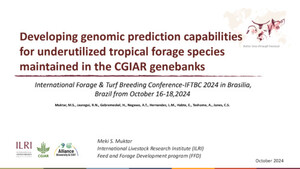
Integrated maize management options to improve forage yield and quality on smallholder farms in Kenya
Abstract
Maize provides an important source of forage for the maize–dairy farmers in Kenya. However, due to small farm size, maize cannot supply all the feed needed for dairy cattle and forage is in short supply in the dry seasons. This paper examines practices to increase the health and use of maize and increase forage quality and quantity. The paper uses data from participatory on-farm research on cultural management practices of maize and on-station field trials in which plants were artificially infected with maize streak virus disease (MSVD) in the intensive maize–dairy production systems in central Kenya. Findings showed that smallholder farmers have deliberately changed the maize management practices by planting densely and systematically thinning the crop to obtain both fodder and grain. They perceived MSVD to have the greatest effect on forage yields and to be a difficult disease to control. Maize management trials showed that increasing plant density increased forage yields by up to 41% but decreased grain yields by up to 17% when specific thinning regimes were applied fairly late in the growth of the crop. However, grain yields were maintained when maize was planted at high density and then progressively thinned for forage during the growing season according to the crop situation or need for forage. The on-station research is the first study on the impacts of MSVD on maize forage and was carried out to increase production of forage during the wet seasons through use of resistant cultivars and agronomic interventions with a view to mitigating forage shortages during the dry seasons. MSVD infection was achieved with artificially infected leafhoppers (Cicadulina mbila (Naudé) (Hem.: Cicadellidae). In the 2001 short rainy season (SRS), early infection (14 days after crop emergence) reduced thinning yields by 43% in the susceptible cultivar, H511, compared to only 22% in a tolerant one, KH 521. Stover yields were reduced by 24% in H511 while there were no significant losses in KH 521. Interestingly, the local landrace, Gikuyu, was tolerant of MSVD in terms of grain yield but not thinnings. Forage from crops infected 35 and 56 days after crop emergence did not differ significantly from the uninfected controls. In the 2002 long and short rainy seasons, early infection with MSV again reduced thinning and stover yields whereas fertilizer and plant density did not significantly affect the influence of MSVD on either maize forage or grain yields. Use of tolerant cultivars provided insurance against forage and grain yield losses caused by early infection by MSV, but yield benefits varied with season. With respect to forage quality, MSVD had a beneficial effect on susceptible cultivars (H511 and H614) due to the higher crude protein (CP) and lower neutral detergent fibre (NDF) concentrations of infected material in the early stages of growth. However, the reduced yields due to MSVD negate any advantage of increase in CP in infected material of susceptible maize cultivars. Further, the benefit of breeding for high NDF concentrations as a defense mechanism against disease effects is disadvantageous to improving quality of maize forage.
Citation
Lukuyu, B.A., Murdoch, A.J., Romney, D., Mwangi, D.M., Njuguna, J.G.M., McLeod, A. and Jama, A.N. 2013. Integrated maize management options to improve forage yield and quality on smallholder farms in Kenya. Field Crops Research 153: 70-78.









